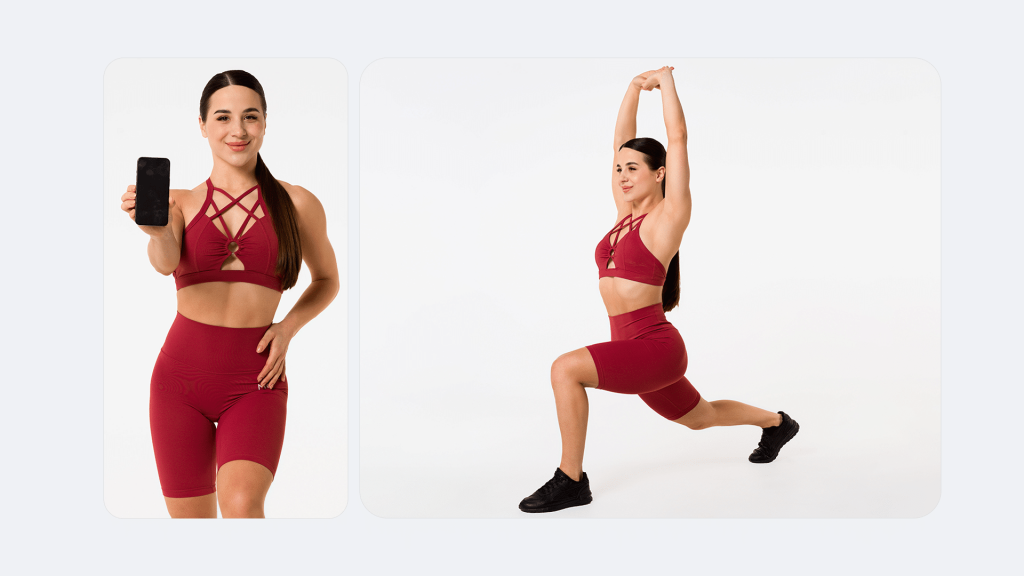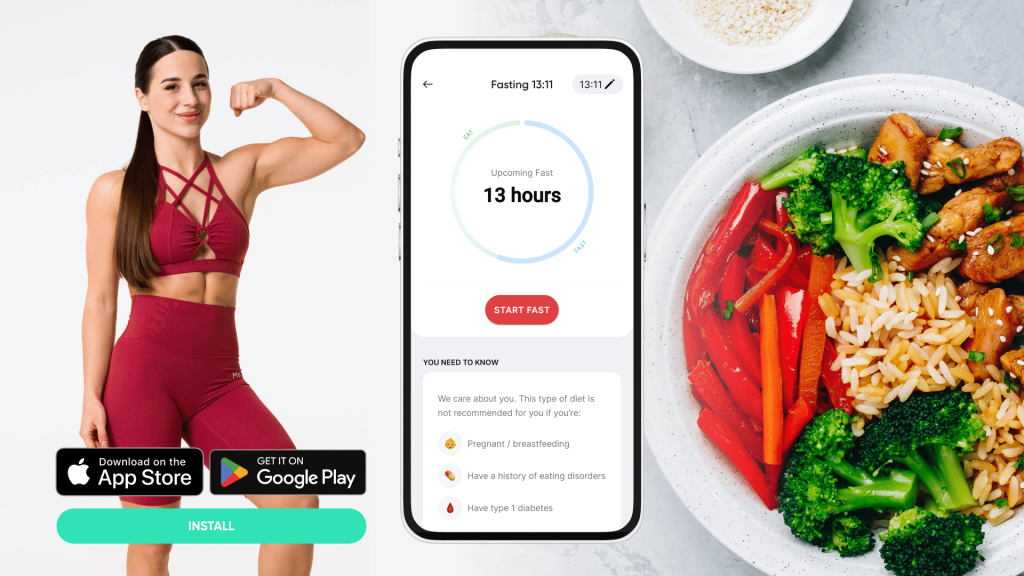Intermittent fasting-we’ve all likely heard of it, many are doing it, and still others are uncertain about it. For many it’s proven to be a great way to burn fat and lose weight, among other possible benefits. Like most things in life, there are right and wrong ways to do intermittent fasting. Unfortunately, beginners and even those who have been doing it for a while can make common mistakes that not only hamper their results but could also lead to health issues. Regardless of where you stand on the IF spectrum, here are 10 of the most common intermittent fasting mistakes people make and how to avoid them.
Mistake 1: Not Choosing The Right Intermittent Fasting Plan
Taking a one-size-fits-all approach to intermittent fasting is one of the biggest mistakes people make. Not everyone’s body responds the same way to fasting. What works for some may not work for you.
That’s why it’s important to find a plan that fits your lifestyle, schedule, and goals. It’s important to note that there are many different types of intermittent fasting plans to choose from (5):
- 16/8 – This is the most common type of IF. You fast for 16 hours, usually overnight, and eat within an 8-hour window.
- 24-Hour Fast – This is exactly what it sounds like. You fast for 24 hours, usually once or twice a week.
- 5:2 Diet – On 2 non-consecutive days of the week, you eat 500-600 calories. The other 5 days you eat normally.
- Alternate Day Fasting – On fasting days, you eat 25% of your normal caloric intake. On non-fasting days, you eat normally.
- The Warrior Diet – This is a 20-hour fast with a 4-hour eating window.
- The Eat-Stop-Eat Method – This is a 24-hour fast once or twice a week.
Why It’s A Problem
Choosing a plan that’s too strict or not well suited for your lifestyle is a recipe for disaster. You’re more likely to cheat or give up altogether if you’re constantly hungry or feeling deprived.
On the flip side, if you choose a plan that’s too lax, you won’t see the results you’re looking for. In addition, you won’t be pushing your body to its full potential.
How To Fix It
The best way to find the right intermittent fasting plan is to experiment with different methods until you find one that works for you. Start with a 16/8 split and see how you feel. You can also work in different length fasting windows on different days of the week according to your schedule – like 12/12 or 14/10 on days when 16/8 just doesn’t fit or you don’t feel up to it. If you’re struggling with doing some type of fasting every day, try a 24-hour fast or the 5:2 diet.
Remember, there is no one perfect plan. The key is finding one that you can stick to long-term without feeling deprived or restricted.
Read More: Intermittent Fasting Snacks: 10 Plus Healthy Bitings That Will Help You Stay On Track
Mistake 2: Not Considering Your Lifestyle
The most successful lifestyle changes are the ones that are easiest to stick to. That’s why it’s important to consider your lifestyle when choosing an intermittent fasting plan.
There are several aspects of your lifestyle that determine whether a particular fasting plan will work for you:
- Your schedule – If you have a busy lifestyle with little time for meals, an 8-hour eating window every day may not be feasible.
- Your dietary restrictions and preferences – Some fasting plans allow for more flexibility than others.
- The number of meals you eat per day – If you’re used to eating 3 meals a day, going to an all-day fast may be too difficult.
- How active you are – active people require more energy and need to eat more often than sedentary people.
- Your social life – If you have a busy social life, avoiding restaurants and social gatherings may be difficult.
Why It’s A Problem
Not considering your lifestyle when choosing an intermittent fasting plan can make it very difficult to stick to. You’re more likely to cheat or give up if you’re constantly struggling to fit fasting into your already busy schedule.
How To Fix It
The best way to fix this mistake is to choose an intermittent fasting plan that fits your lifestyle. Bear in mind that IF is all about time-restricted eating, so any plan that allows you to eat within a set timeframe will work.
If you have a busy lifestyle, try the 16/8 method or the warrior diet. If you have an active social life, you may find it easier to do a longer fast once or twice a week on days when you don’t have social engagements, like the 24-hour fast or the alternate day fasting method.
Mistake 3: Not Eating Enough When You Break Your Fast
People often confuse IF with dieting. This leads to the common misconception that you should eat very little during your eating window. This is not only ineffective, but it can also be dangerous.
In reality, there’s a huge difference between the two. IF restricts the time you eat, while dieting restricts the type and amount of food you eat. The whole point of IF is to give your body a break from digesting food.
Why It’s A Problem
Underneath all the fat you’re trying to lose, your body has lean muscle. This muscle is important because it helps you burn calories, even when you’re resting, plus you need it to do all the daily activities of life (6). When you don’t eat enough on fasting days, your body starts to break down this muscle for energy.
This not only slows down your metabolism, but it can also cause muscle wasting and fatigue.
Undereating also makes you more likely to binge eat later. This can offset any weight loss you’ve achieved and make it harder to stick to your plan in the long run.
How To Fix It
The best way to fix this mistake is to make sure you’re eating enough during your eating window. How do you know how much is enough?
A good rule of thumb is to calculate your body’s energy and protein needs based on individual factors, activity level, and your goals. This will help prevent muscle loss and keep your metabolism ticking over (5).
Depending on the type of fasting you’re doing, spread the calories out over the course of your eating window in 2-4 meals.
If you’re not sure how many calories you need, there are plenty of online calculators that can help you out.
Another option is to use the hand-size method. This involves eating one palm-sized portion of protein, one fist-sized portion of vegetables, and one cupped-hand portion of carbohydrates at each meal.
Intense sweat sessions, working weight loss tips, lip-smacking recipes come in one package with the BetterMe app. And all of it is at your fingertips, start transforming your life now!
Mistake 4: Eating Too Much When You Break Your Fast
Hunger after a fast is completely normal, but eating too much can quickly offset any weight loss you’ve achieved. This is another common mistake that people make when they start intermittent fasting.
The hormone ghrelin is responsible for making you feel hungry, and it’s also responsible for increasing your appetite after a fast. When you overeat, ghrelin spikes and makes you even hungrier than you were before. This can quickly lead to weight gain and stalled progress (2).
Why It’s A Problem
Overeating negates the benefits of IF and can lead to weight gain. It also makes it harder to stick to your fasting plan in the long run.
How To Fix It
Start by eating a small, nutritious meal when you break your fast. This will help stave off hunger without overeating. Here are some nutritious, filling meals you can use to break your fast:
- Yogurt with chia seeds
- Bone or vegetable broth
- A small salad with grilled chicken
- A veggie omelet
- A green smoothie
- A bowl of fruit
You can also try drinking a glass of water or herbal tea before meals to help you feel more full.
And if you’re still struggling, try eating more protein- and fiber-rich foods. These nutrients are known for their ability to help control hunger and promote satiety.
If you’re still feeling hungry after your first meal, wait 20-30 minutes before having a second. This will give your body time to register that it’s full.
Read More: Fasting Drinks: The Dos And Don’ts Of Hydrating During A Fast
Mistake 5: Choosing The Wrong Foods During Your Eating Window
The eating window is the time when you’re allowed to eat whatever you want. And while there are no rules about what you can and can’t eat, some foods are better than others.
Ultra processed junk food, sugary drinks, and refined carbs will spike your insulin levels and contribute to weight gain. On the other hand, whole foods like vegetables, whole grains, lean protein, and healthy fats can help you lose weight and improve your health (1).
Why It’s A Problem
Eating processed junk food negates the benefits of intermittent fasting and can lead to weight gain. It can also contribute to other health problems, like diabetes, heart disease, and high blood pressure (1).
Furthermore, your body responds differently to whole foods and highly processed foods. Whole foods are digested more slowly, which means they don’t cause the same spike in insulin levels as highly processed foods do. Whole foods can help you lose weight and improve your health (1).
How To Fix It
Eliminate ultra processed junk food from your diet and replace it with whole foods. Here are some healthy, whole foods you can include during your eating window:
- Vegetables
- Fruit
- Lean protein
- Nuts and seeds
- Whole grains
- Healthy fats
Here are some foods that you should avoid:
- Sugary drinks
- Refined carbs e.g. white bread, pastries
- Processed meats e.g. bacon, sausage
- Junk food e.g. candy, cake, cookies
Mistake 6: Not Staying Hydrated
Water is essential for weight loss, regardless of whether you’re fasting or not. Drinking plenty of water while fasting helps you feel fuller and less prone to cravings. Furthermore, your body functions better when it’s well hydrated (4).
Why It’s A Problem
Not staying hydrated can lead to dehydration, which can cause a slew of health problems. These include (7):
- Headache
- Dizziness
- Fatigue
- Nausea
- Constipation
Furthermore, dehydration can make it harder to lose weight. This is because water helps to flush out toxins and keep your metabolism working properly.
How To Fix It
Drink at least 8 glasses of water a day, especially during your fasting periods (7). You can also drink other beverages like unsweetened green tea or herbal teas.
While unsweetened black coffee is okay in moderation, caffeine can dehydrate you. So make sure to drink an extra glass of water for every cup of coffee you have.
If you struggle to even flirt with the idea of giving up your favorite foods or working out till your legs give way – BetterMe app is here to breathe a fresh perspective into the way you view the weight loss process! Check out the app and experience the fun side of fitness and dieting with BetterMe!
Mistake 7: You’re Unknowingly Breaking Your Fast
Many people don’t understand what a clean fast means. A clean fast, which is what you’re expected to do during your fasting window, means not consuming anything but water, black coffee, and unsweetened tea.
It’s important to be aware of what you’re drinking during your fast because many common drinks contain hidden calories and carbs.
Foods that are close to zero calories or labeled “diet” or “zero-calorie” are often full of artificial sweeteners, some of which can break your fast.
Why It’s A Problem
Consuming anything other than water, black coffee, and unsweetened tea during your fasting window can break your fast and negate the benefits of intermittent fasting. This can lead to frustration and discouragement, and may even cause you to give up on intermittent fasting altogether.
Furthermore, some of the benefits of fasting such as ketosis and autophagy only occur after an extended period of time without food (5). So if you’re constantly breaking your fast, you may never experience these benefits.
How To Fix It
If you’re not sure whether a drink is allowed during your fast, check the ingredients list. If it contains any sugar or artificial sweeteners, it’s best to avoid it.
Look out for products containing:
- Sugar or sugar alcohols – common names include sucrose, fructose, maltose, lactose, xylitol, and erythritol
- Artificial sweeteners – common names include aspartame, saccharin, and sucralose
- Natural sweeteners – common names include honey, agave nectar, and maple syrup
Mistake 8: You’re Not Exercising
Whether you’re trying to lose weight or improve your health, exercise is important. Exercise helps to increase your metabolism, burn calories, and improve insulin sensitivity. All of these things are beneficial for weight loss and improved health (3).
Why It’s A Problem
If you’re not exercising while intermittent fasting, you’re missing out on some of the benefits of fasting. Exercise helps to increase your metabolism and burn calories, both of which are necessary for weight loss (5).
Muscle loss is also a common problem among people who fast. This is because when you’re fasting, your body starts to break down muscle tissue for energy. This can lead to a loss in muscle mass and a decrease in your metabolic rate (9).
Having a strength training routine can help prevent this and may also build muscle, which can help you lose weight in the long term (9).
How To Fix It
Intermittent fasting is not an excuse to avoid exercise. In fact, exercising while fasting can help you burn more fat and improve your health.
Aim for at least 30 minutes of moderate-intensity exercise most days of the week. This could include walking, biking, swimming, or light weight training.
If you’re new to exercise:
- Start slow and gradually increase your intensity and duration over time.
- Time your workouts around your eating windows. This will help make sure you have the energy to fuel your workouts.
- Don’t overdo it. Overtraining can counteract the benefits of fasting and actually make you gain weight.
- Stay hydrated before, during, and after your workouts. Drink plenty of water and avoid sugary sports drinks.
Mistake 9: You’re Not Sleeping Enough
Getting enough sleep is important for both your physical and mental health. Not only does it help you recover from exercise, but it also helps to regulate your appetite.
Why It’s A Problem
When you don’t get enough sleep, your body produces more of the hormone ghrelin. This hormone increases your appetite and makes you crave high-calorie foods (8).
Not getting enough sleep can also lead to weight gain. This is at least partly because it can disrupt your body’s ability to regulate blood sugar and insulin levels (8).
How To Fix It
Aim for 7-9 hours of quality sleep per night (8). If you have trouble sleeping, try some of these tips:
- Create a bedtime routine and stick to it
- Avoid caffeine and alcohol before bed
- Exercise regularly
- Keep your bedroom cool, dark, and quiet
Mistake 10: You’re Not Being Patient
Weight loss is a slow process. It can take weeks or even months to see results. This can be frustrating, especially if you’re used to seeing results quickly.
Even if you’re not getting into IF for weight loss, most of its benefits come with time.
Why It’s A Problem
When you’re not getting the results you want, it can be tempting to give up. This can lead to yo-yo dieting and weight gain.
Yo-yo dieting is a cycle of losing and gaining weight. It’s dangerous for your health and can make it harder to lose weight in the future.
The frustration when you’re not seeing results fast enough can also lead to making other mistakes, such as not eating enough or overdoing it with exercise.
How To Fix It
Be patient and give your body time to adjust. Remember that weight loss is a slow process and can take weeks or even months to see results.
Focus on other potential benefits of intermittent fasting, such as improved mental health, energy levels, and digestion (5).
If you’re struggling with your weight, seek professional help. A dietitian or nutritionist can help create a plan that’s right for you and help you stay on track.
The Bottom Line
Intermittent fasting can be a great way to lose weight or potentially improve your health, but it’s not for everyone.
There are a few mistakes that people often make when they start intermittent fasting. These include not eating enough, overdoing it with exercise, and not being patient.
If you’re thinking about starting intermittent fasting, be sure to do your research and talk to your doctor first. Once you start, be sure to focus on the benefits and stay patient. It can take time to see results.
DISCLAIMER:
This article is intended for general informational purposes only and does not serve to address individual circumstances. It is not a substitute for professional advice or help and should not be relied on for making any kind of decision-making. Any action taken as a direct or indirect result of the information in this article is entirely at your own risk and is your sole responsibility.
BetterMe, its content staff, and its medical advisors accept no responsibility for inaccuracies, errors, misstatements, inconsistencies, or omissions and specifically disclaim any liability, loss or risk, personal, professional or otherwise, which may be incurred as a consequence, directly or indirectly, of the use and/or application of any content.
You should always seek the advice of your physician or other qualified health provider with any questions you may have regarding a medical condition or your specific situation. Never disregard professional medical advice or delay seeking it because of BetterMe content. If you suspect or think you may have a medical emergency, call your doctor.
SOURCES:
- Eating highly processed foods linked to weight gain (2019, nih.gov)
- Ghrelin: much more than a hunger hormone (2014, nih.gov)
- Health Benefits of Exercise (2018, pubmed.gov)
- Increased Hydration Can Be Associated with Weight Loss (2016, nih.gov)
- Intermittent Fasting: Is the Wait Worth the Weight? (2019, nih.gov)
- Metabolism and weight loss: How you burn calories (2020, mayoclinic.org)
- Public knowledge of dehydration and fluid intake practices: variation by participants’ characteristics (2018, nih.gov)
- Short Sleep Duration is Associated with Reduced Leptin, Elevated Ghrelin, and Increased Body Mass Index (2004, nih.gov)
- The Effects of Intermittent Fasting Combined with Resistance Training on Lean Body Mass: A Systematic Review of Human Studies (2020, nih.gov)












